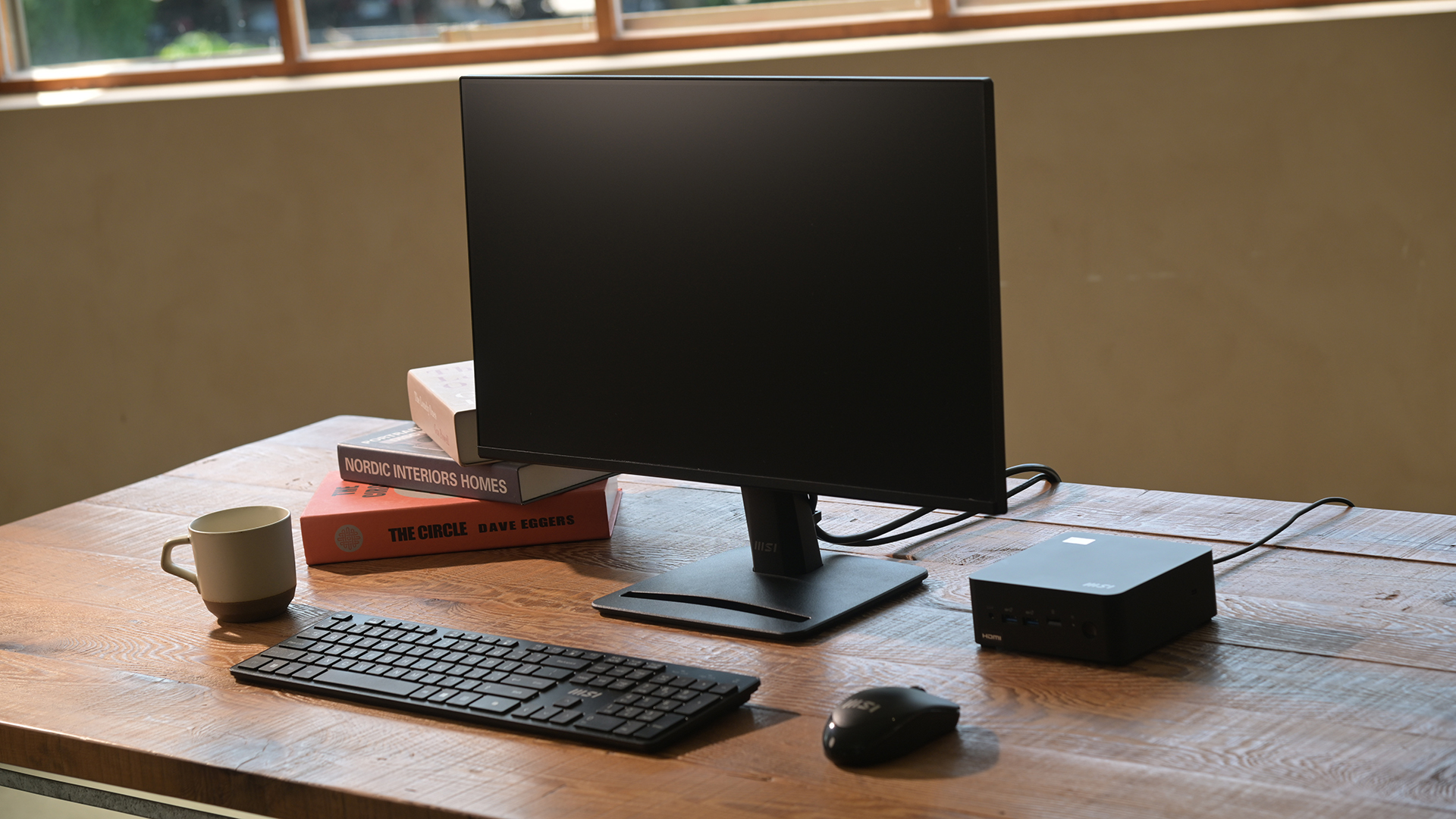Sponsored by MSI
What are the benefits of a mini PC?
All the power and connectivity of a desktop computer, in a form factor you can hide around the back of a monitor – what’s not to like?

“Good things come in small packages” is an idiom often used and one that feels quite apt when talking specifically about the mini PC. Indeed, in this age of remote work and super processing power, the small version of the desktop computer is a multifaceted marvel that can save time, money, and space.
There’s also an environmental benefit, too. These small computational cubes are changing the way we work as well as helping to reduce carbon footprints with energy-efficient features.
If your business is approaching its hardware refresh, if your office needs more innovative computers that take up less space, or if you just want something powerful but portable to send out to your remote workers, the mini PC is right for you…
Why go for a mini?
The most attractive selling point with mini PCs is the ‘mini’ part; they take up the tiniest amount of space and leave your desk free for more equipment – or no equipment at all. Some models can be fitted to the back of a monitor via a VESA mount, making the device practically invisible from the desk.
They’re ultra-portable, easy to fit in a rucksack, suitcase, or possibly a purse, and they’re a dream to ship out if you're an IT manager who needs to send new machines to remote workers. Think of them as tiny but super-effective cubes of computational power fit for the modern workforce.
The portability of mini PCs makes them suitable options for those who need to compute on the go without compromising performance. That said it is worth keeping in mind that you also need peripherals, like a monitor and keyboard, so you need to check that your next destination has those at the ready. You may also want to check how many monitors are available, because port selection on most mini PCs allows you to connect to multiple displays – in some cases, up to four.
This is where there is a huge advantage over the modern laptop, specifically if you have monitors already set up on desks. Laptops are getting thinner and it’s largely port selection that is paying the price; card readers, headphone jacks, HDMI slots, and even good old USB A ports are all being left out, limiting your options for connections.
Some manufacturers have tried to find a software solution for this. Take Apple’s M3 MacBook Air, which can connect to two monitors, but you need to have the lid of the laptop closed. So in reality, you’re only adding one screen in that scenario as you lose the laptop's display – a mini PC sounds more like a sensible solution here.
And you’ll certainly pay a lot less for a mini PC than a premium laptop. A mini PC unit can be as little as $50 while the most expensive models average around $1,400 – still lower than a MacBook.
You may also save money through energy efficiency; mini PCs tend to use low-power processors with a thermal design power generally under 17W – traditional desktops usually hit near 150W, roughly ten times more than your average mini PC.
Offices, schools, hospitals, and beyond…
There has been a sharp rise in the use of mini PCs in the educational sector over the last few years with colleges and schools turning away from the traditional desktop computer. The compact designs and versatility, not to mention the lower prices, of mini PCs appeal greatly to teachers and students alike. The silent nature of the mini PC is also a great quality to have in libraries and study areas.
Hospitals and medical facilities are also workplaces that can benefit from the small and versatile nature of the mini PC. Busy wards, hot desks, and onsite laps are just some of the areas where a portable yet powerful computer enhances the workflow.
And, while the 4x4 size is generally what we think of for mini PCs, there are many use cases for them beyond these small desktop boxes. Think digital signage, like customer-facing kiosks, and touch screens in shops, restaurants, and public spaces. Here, the potential is only just being realized and it won't be long before generative AI is at the fingertips of everyone accessing a customer-facing display. The mini PC is at the forefront of this digital transformation.
So when it comes to mini PCs you should look for the best of the best and opt for a model from a specialist manufacturer, such as MSI, which has the superb Cubi NUC 1M. The NUC 1M is a fine mini PC that offers stellar performance in a small package – it’s also very quiet. The chassis is upgradeable with SO-DIMM slots, M.2 socket, and the 2.5in SATA bay all easily accessible behind a few screws on the bottom. What’s more, the Cubi is a productivity powerhouse as it can support up to four monitors with its HDMI and Thunderbolt 4 slots.
Its VESA-mounted design allows users to connect the whole device to the back of a monitor, hiding it from the desk – for extra space. And it also comes with dTPM 2.0 technology for added security. ‘TPM’ (Trusted Platform Module) means the Cubi is designed to provide hardware-based security functions, including encryption keys, on the device, for all your sensitive data.
The Cubi also has on-device controls to manage its CPU power consumption, via its MSI Center software. Here, it uses a graph to highlight how much power the system has pulled through its power outlet – a great addition for office managers who have multiple devices running continuously throughout the day.
In July 2024, the Cubi NUC series of mini PCs was given a Red Dot Design Award in recognition of MSI’s design and innovation dedication and excellence.
So when the time comes to find new hardware for the office, or whatever your business is, don’t think too big, think mini PC, instead.
Get the ITPro daily newsletter
Sign up today and you will receive a free copy of our Future Focus 2025 report - the leading guidance on AI, cybersecurity and other IT challenges as per 700+ senior executives
Bobby Hellard is ITPro's Reviews Editor and has worked on CloudPro and ChannelPro since 2018. In his time at ITPro, Bobby has covered stories for all the major technology companies, such as Apple, Microsoft, Amazon and Facebook, and regularly attends industry-leading events such as AWS Re:Invent and Google Cloud Next.
Bobby mainly covers hardware reviews, but you will also recognize him as the face of many of our video reviews of laptops and smartphones.
-
 Bigger salaries, more burnout: Is the CISO role in crisis?
Bigger salaries, more burnout: Is the CISO role in crisis?In-depth CISOs are more stressed than ever before – but why is this and what can be done?
By Kate O'Flaherty Published
-
 Cheap cyber crime kits can be bought on the dark web for less than $25
Cheap cyber crime kits can be bought on the dark web for less than $25News Research from NordVPN shows phishing kits are now widely available on the dark web and via messaging apps like Telegram, and are often selling for less than $25.
By Emma Woollacott Published
